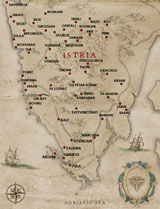to enlarge


or choose the place
from the menu below
 Rome |
 Byzantium |
 Venice |
 Vienna |
 Brioni |
 Smrikve |
 |
 |
Just to give you an idea of Roman building capacity I found the information that the Consular Road Via Flavia from Trieste to Pula, over 100 kilometres long, was built in only one year. Also the aqueduct from Ucka to Pula, over 60 kilometres long, was built in a very short period of time. They could have built all this small circular ground-plan houses with roof of stone slates named kazuni in a reasonable amount of time. In reality they had six centuries to build them. I hope you found interesting this short note about Roman Istrian times.
In Roman Empire in Istria photo gallery you will find few photos of the most beautiful monuments from the Roman times but I also strongly advise you to look at the Istrian map during the Roman Empire period. The basic idea behind this map is to give you an overview of three main types of roads Roman built over time and also the main towns they developed mostly on pre-historic hillfort settlments with their old Roman names.